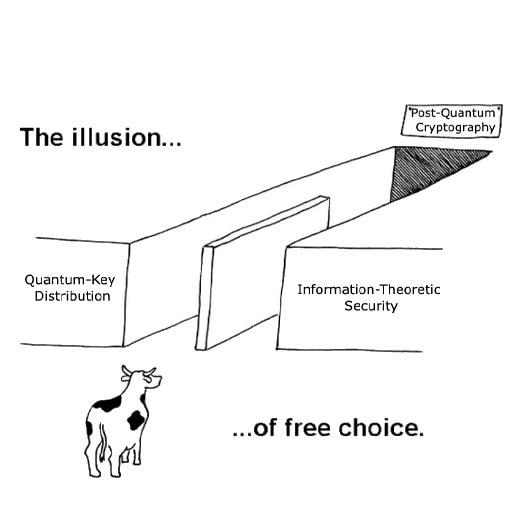Introduction
The rise of quantum computing is often framed as a threat – one that could render traditional encryption methods obsolete. While this is true, the transition to post-quantum cryptography (PQC) is not just about maintaining security. It is also bringing a wave of innovation, customisation, and new possibilities for businesses and industries worldwide. I’m not just talking about how this is an opportunity to sell solutions; there are actual practicalities that may benefit all sectors.
As we move into this new era, the cryptographic landscape is evolving beyond the “one-size-fits-all” approach that has dominated digital security for decades. Instead of a singular reliance on RSA or ECC for all cryptographic needs, organisations now have the flexibility to pick and choose their cryptographic implementations to suit specific use cases.
Goodbye One-Size-Fits-All Cryptography
Historically, cryptographic systems have been built around a few dominant algorithms, such as RSA and ECC. These were used across all domains – digital signatures, key exchanges, secure communication… you name it. That’s what everyone used, regardless of different computational and efficiency requirements. This could prove especially painful for IoT and embedded devices, that sometimes even have to sacrifice longevity to run encryption algorithms.
With the advent of post-quantum cryptographic algorithms, we now have a diverse set of tools at our disposal. Algorithms differ significantly in terms of key size, computational efficiency, and resistance to different types of attacks. This allows organisations to choose the most efficient and effective cryptographic solutions for their specific needs.
Let’s take, for example, FN-DSA and ML-DSA, two NIST-approved post quantum digital signatures: FN-DSA, with its smaller signature size, is ideal for blockchain and cryptocurrency applications, where storage and transaction efficiency are key. On the other hand, ML-DSA, despite its larger signature size, is better suited for high-traffic network environments due to its lower computational time.
Even within the same algorithm, more options are provided. For example, ML-KEM, the winner of the 2024 round in the NIST competition for key exchange algorithm, provides three levels (based on different inputted parameters) that offer different balance between security, key size, computational speed and performance. Essentially, higher levels of ML-KEM offer stronger security at the cost of larger key sizes, while lower levels are optimised for rapid key exchanges in latency-sensitive applications.
This flexibility means that organisations no longer have to compromise between security and efficiency, they can choose the right tool for the job.
Enforced Innovation: The Need for Crypto-Agility
One of the biggest challenges in the transition to PQC is interoperability. Currently, encryption standards are largely universal, making it easy for different systems and organisations to communicate securely. However, with multiple post-quantum algorithms being developed, different actors may adopt different cryptographic standards, leading to compatibility issues.
At first glance, this might seem like a major hurdle, but on the other hand, it forces innovation. The need to resolve these incompatibilities is likely to drive the development of better cryptographic frameworks, cross-platform security solutions, and even entirely new methods of cryptographic negotiation.
This could lead to breakthroughs in standardisation and cross-compatibility tools, that allow different cryptographic systems to seamlessly communicate, even if they use different algorithms.
It will also motivate the development of more adaptable security frameworks, encouraging businesses to implement crypto-agility, the ability to switch cryptographic mechanisms without overhauling their entire infrastructure.
Finally, it may lead to new developments in software architecture: The push for better cryptographic compatibility may drive improvements in how different programming languages, platforms, and frameworks interact, solving longstanding issues that extend beyond security.
The difficulty organisations face in the migration to PQC shows us just how inflexible our current infrastructure is; every major change has to deal with compatibility issues with legacy systems. This is a long standing issue for the youngest startups as well as the biggest governments. This is our chance to reshape the industry to become more dynamic and adaptive, which is a necessity to survive in a dynamic technological world.
Future-Proofing Digital Infrastructure
Beyond immediate security concerns, PQC is setting the stage for long-term improvements in digital infrastructure. Companies that adopt crypto-agility today will not only be prepared for quantum threats but will also be better equipped to handle future advancements in cryptographic research, secure communication protocols, and data privacy standards. We’re already uncovering AI-enabled attacks on symmetric keys, and this is an area that’s unclear how it’ll end up affecting our cryptographic systems. We need to be ready to adapt to the potential upcoming AI threats, any additional quantum breakthroughs that may render even the latest PQC algorithms insecure, or some other new technology that may come about in the future.
Industries that rely on secure communication, such as finance, healthcare, and telecommunications, will need to be at the forefront of these developments. The businesses that proactively integrate flexible and adaptable security solutions will gain a competitive advantage, ensuring that they are not only protected but also optimised for the digital future.
Conclusion: A New Era of Cryptographic Possibilities
The transition to post-quantum cryptography is not just about mitigating threats – it’s about seizing new opportunities. The diversity of cryptographic algorithms enables organisations to fine-tune their security solutions, rather than being constrained by legacy encryption standards. Meanwhile, the challenge of interoperability is driving innovation, pushing industries toward more flexible, resilient, and efficient security architectures.
Instead of viewing the quantum era as a risk, businesses should see it as an opportunity to modernise, customise, and optimise their cryptographic strategies. Those who embrace this shift early will not only secure their data but also position themselves as leaders in the new frontier of digital security.








